|
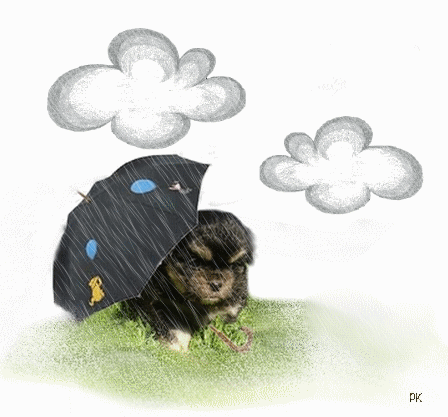

,

All 3 languages on this same page
Les 3 traductions sur cette même page
.
Nouvel apport de lignées en Europe
1990 - 2006
Pour Information
Introduction
A la mondiale
1998, à Helsinki / Finlande, lors de la réunion du ITSWP / International Tibetan Spaniel Working Party, à laquelle j’assistais, M Primoz Peer de Slovénie a présenté des chiens du Bhutan.
De nombreux éleveurs se sont
intéressé à ces chiens appellés
« Natifs »
par M Primoz Peer, d'autres donne l'appellation de Mutts ou Mongrols, de croissés, nous nous parlerons de "Multi-Origines". Nous-mêmes
sans préjugés avons même accepté de faire saillir nos mâles épagneuls
sur les femelles alors présentées. Mais aux fils des générations produites avec ces nouveaux
apports, métissés avec des épagneuls du Tibet, de nombreux éleveurs à travers le monde ont commencés à approfondir leurs
recherches car la descendance ne correspondait en de nombreux points pas du tout à l’épagneul ni à son standard. par sa Morphologie, angulations,
proportions, couleurs, expression de tête, caractère beaucoup plus dominant, nombreuses Hernies sont sorties chez
les chiots, des lux des PL plus fréquantes sont apparus aussi . Des fontanelles pas fermées qui n'avais JAMAIS été observé
auparavant dans la race de l'épagnuel tibétian... Nous même qui avions un descendant de ces origines à l'époque, sans l'avoir
utiliser en reproduction, nous avons prit la décision de stériliser et placé dans une famille aimante comme chien
pour la compagnie.
Ci-Dessous un peu "l'historique"
de ces nouveaux courants de sang introduits dans l'épagneul Tibétain au cours de ces dernières années.
D’autres importations au fils des années,
qui comme Chotu
sont des chiens aux Origines Inconnues / Multi
Race
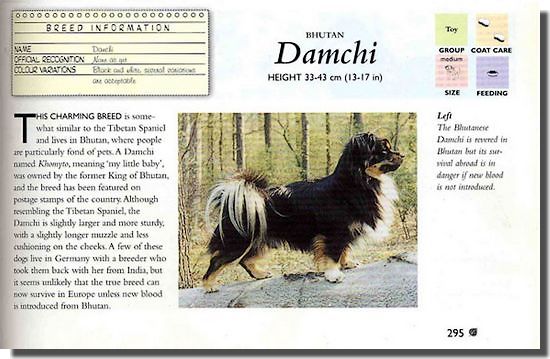
Chotu
Importé du Bhutan en Allemagne
Sans pedigree - Origines inconnues
( était destiné à la compagnie initialement )
A la fin des années 1990, quelques éleveurs d'épagneuls tibétains de divers pays d'Europe
ont mis au point un programme d'élevage afin d'introduire des Damchis du Bhutan dans l'épagneul tibétain. Si le Damchi
est un cousin de l'épagneul tibétain dans la cynologie, il n'en reste pas moins une race différente.
Il faut savoir que l'épagneul du Tibet fait partie du 9ème groupe ( les chiens
de compagnie ), race patronnée par l'angleterre, reconnue par la fédération cynologique internationale ( FCI ).
Mais en revanche le Damchi du Bhutan, est une race connue, mais
PAS RECONNUE
Dans la lettre de la Fédération de la Société Cynologique d'Inde en
datée du 21 février 1987, il est dit
"le Damchi est une race de Thimpu - Bhutan, le palais Royal du Bhutan a quelques
Damchi Terriers, qui ressemblent à des Lhassa Apsos avec moins de poils tombant sur les yeux et suite à divers croisements
moins de manteau que le terrier, ils leurs ont donné l'appellation de "DAMCHI" et ces Damchi on été croisés avec des épaneuls
tibétains."
Le Pool de base des lignées de l'épaneul est en ce jour assez diversifié, large et amplement
suffisant, sans qu'il soit nécéssaire d'avoir recours à l'introduction des Damchi pour garantir la survie de l'épagneul.
Un point intéressant à soulever:
La propriétaire de Chotu en Allemagne à donné l'information concerant ce chien à Juliette
Cunlffe,( l'auteur de l'encyclopédie des cheins de races reconnues ou connues) que Chotu était un "Damchi"
...
Il est classé sous " Autres races connues" mais pas reconnues par le Kennel Club anglais
détenteur du standard ...
Il est décrit comme suit
" Cette charmante race est en CERTAINS points similaires à l'épagneul tibétain et
vit au Bhutan, où le peuple est très attaché aux animaux de compagnie.
Un Damchi nommé "Khomy", qui signifie "mon petit bébé" appartenait au Roi du Bhutan
et son effigie a été aposée sur les timbres postaux du pays".
Malgré une certaine ressemblance avec l'épagneul, le Damchi est un peu plus grand (
33cm à 43cm ), n'a pas les mêmes angulations ou proportions dans la construction et le nez est un peu plus long et il a moins
de rembourrage.
Quelques Damchis d'origine vivent en Allemagne mais sans apport de nouvelles importations le Damchi est
appelé à disparaitre d'Europe.
La question soulevée par de nombreux éleveurs ...
y a t'il eu croisement entre le Damchi et Epagneul du Tibet et mis sous l'appellation
d'Epagneul du Tibet ?
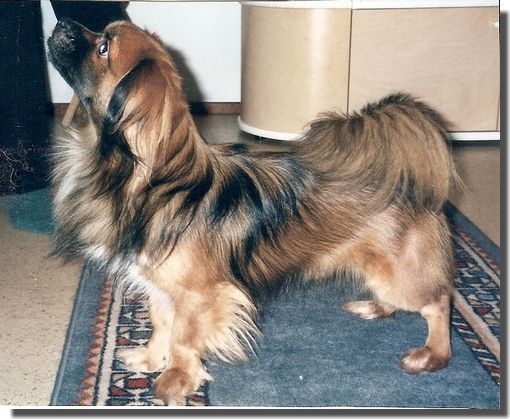
Produced by Chotu - Pictured by Lollipop Kennel
Descendance de Chotu - Type dit Damchi - Adulte

also / aussi descendance Chotu un puppy / jeune
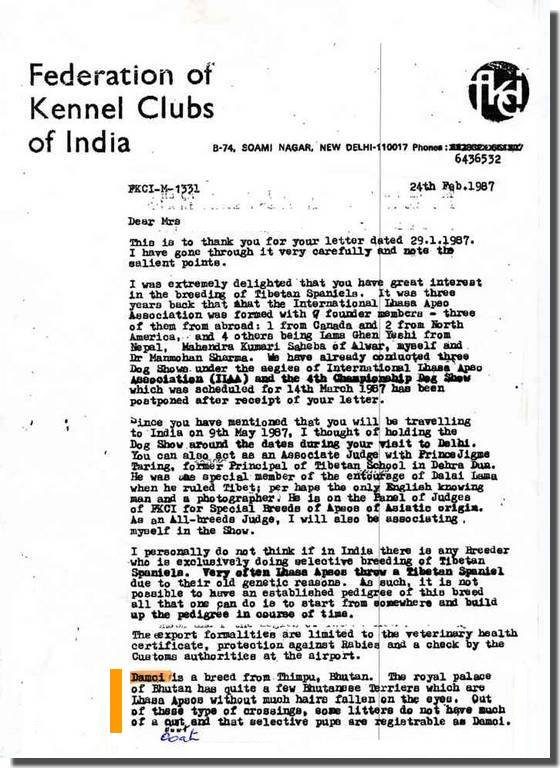
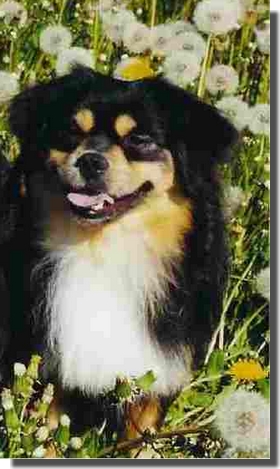
Descendance Chotu mis avec un Epagneul du Tibet ......

2001
Leopoldo
de Kyngyzstan à l'Italie
Laura Bonzell de Rome, avais acheté en 1992 un chiot nommé Leopoldo sur un
marché dans la cité de FranzBshkek - Kyngzstan. Les pesonnes qjui le lui ont vendu lui ont dit qu'ils avaient ses
parents et sa soeur, tous très similaires ( de couleur / noir )
FranzBiskek est une ville sur l'ancienne route de la soie elle est encore le point de
départ des voyages en destination du plateau nord tibétain.
Leopoldo, "Damchi" d'apparence, a été importé sans pedigree et est maintenant
enregistré en Slovénie sous les réglementations FCI comme épagneul tibétain. Il a déjà produit de nombreuses portées,
et ses chiots sont répartis dans différents pays d'Europe. Impossible de remonter les origines ... Inconnu ...
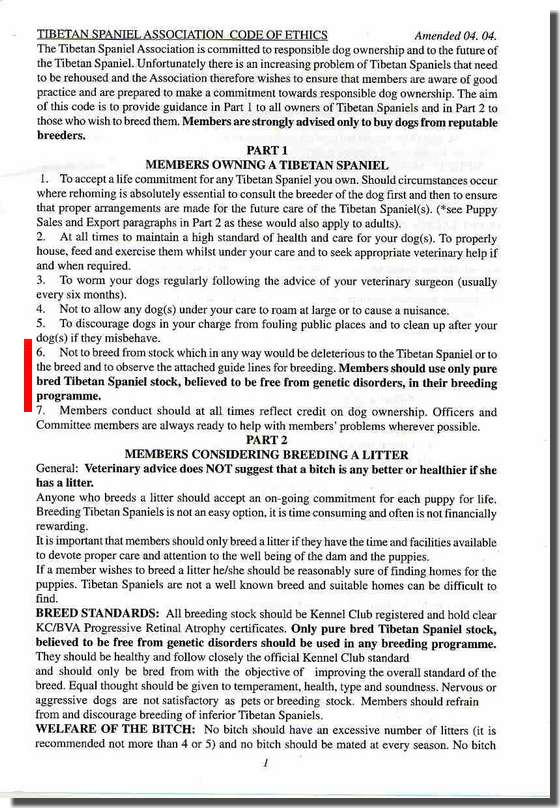

1999
Arty
Arty de père et mère origine inconnue, non enregistrée ( pas de pedigree ).
Est né en 1999, il est venu du nord-ouest de la Chine et sa propriétaire Anita Hummel,
habitant le Guand Dong, provence de Chine, avait reçu ce chien d'un ami qui l'aurat lui-même reçu chiot d'un fonctionnaire
du gouvernement.
Arty est maintenant ... après avoir examiné par 3 juges du Hong-Kong Kennel Club, "un
Certificat B ", qui est le même qu'un titre initial de la FCI et comme the HK KC est membre de la FCI
Mais cela m'interpel ????
Pour pouvoir parler D'ORIGINES autre que "originaire de
HongKong" / du pays - Il faudrai pouvoir avoir la possibillité de remonter les générations / ancêtres et sans cela
il n'est pas possible d'afirmer à 100% que tel chien est plus Epagneul du Tibet que Pékinois, que croissé Lhassa Apso,
ou mélangé shih-Tzu ou Térrier du Tibet ou chien de race indéfinie ....
2005
1ère descendance dÂrty
Tchapo Shiwa - Shiwa Ming Mei - Shiwa Yue
Depuis la Chine jusqu'à la Suisse - la Suède - avec co-propriété en Slovénie
Ces trois chiens sont nés le 21 octobre 2005 de Rombrom Angra
(Chienne issue de l'élevage de M Primoz Peer )
De la première portée issue d'Arty nous voyons une net ascendance Pékinoise dans la
morphologie de ces chiots devenu adultes


A départager ...
L'Epagneul Tibétain connu et travaillé standard
FCI de nos jours
L'Epagneul Tibétain Natif comme décrit ci-desous - Liza / origines connues
Le Damchi du Bhutan - Chotu - race connue
mais pas reconnue FCI
ce n'est pas un epagneul du Tibet
Les multi-race
ou origines inconnues - Style Léopoldo & Arty & autres
Ce sont 4 cas de figure complétment DIFFERENTES
Pourtant
TOUS inscrits sous l'appellation de
Tibetan Spaniel - Epagneul du Tibet ... ???
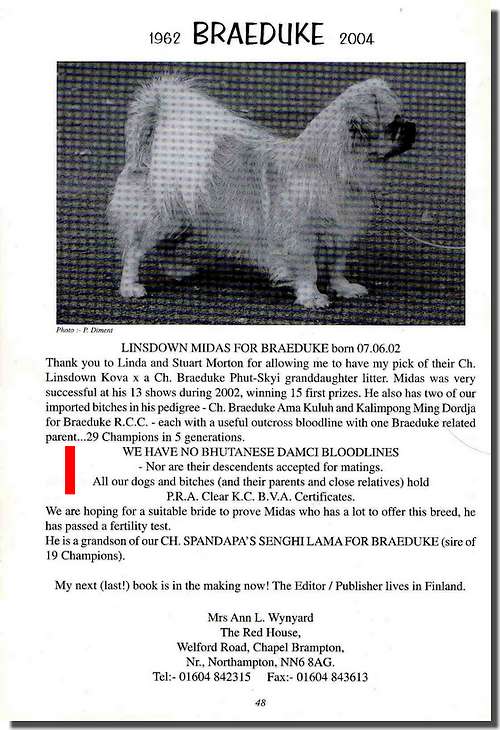
1994
Eaden of Ada
Importé d'Inde en France
Anne-Marie Minotte, Kennel du Houang-Ho, a importé le 22 avril 1993, une femelle,
Eaden of Ada / dite Liza, de chez M Singh, éleveur d'épagneuls tibétains en Inde, avec pedigree à 2 générations.
Sa descendance à été mélangées surtout avec les males
Amko de Karagueuze,
CH Tibroke Ambrier Easy On The Eyes.
CH Chupa Chups of Lollipop
Nice Mic Mac of Lollipop
CH Doux Tam Tam of Lollipop
WW-03-CH Teddy
of Lollipop
Le phénotype en quelques générations est plus proche avec ces lignées natives
que les 3 imports native mentionné précédament.
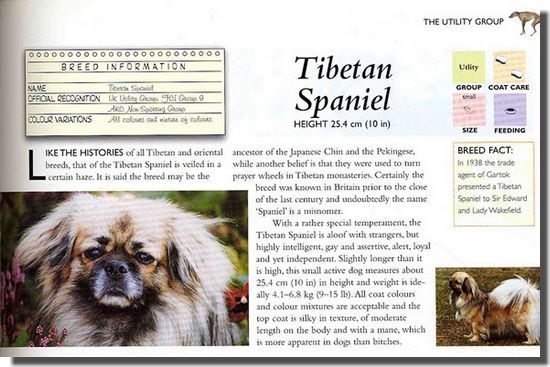
Conclusion
( qui n'engage que moi personnellement )
Je trouve regrettable de faire un mixage de plusieurs races ou chacune de
ces races a ses charmes et points possitifs, nous allons nous retrouver avec un chien qui n'aura plus rien à voir
avec notre Epagneul du Tibet
A préciser que le cheptel mondial du Tibby est très large et il n'est
nulle besoin d'introduire de nouveaux courants de sang pour sa survie ou sa sauuvegarde
En introduisant des origines inconnues chez le Tibby, c'est aussi introduire des courants
de sang inconnus avec leurs maladies & points faibles propre à l'éventail de races non définies derrière.
C'est aussi un déni du travail de sélection des éleveurs du monde entier depuis tant d'années.
Un éleveur, je dis bien éleveur, pas un marchand de chiens ou un néophyte, un éleveur a
la passion, la connaissance de sa race, il va respecter cette race, son histoire, ses origines, son standard,son
évolution, ses caractéristiques & veiller sur sa santé avec les outils vétérinaires mis à sa disposition ...
C'est le rôle d'un Kennel Club, d'un Club de race, d'un éleveur, tous devraient rechercher
la même finalité ... Ûn Epagneul Tibétain au caractère équillibré, sain, conforme au standard FCI
Une race ne nous appartient pas ... Nous en sommes les GARDIENS...
Nous n'avons pas le droit de la dénaturer ...
L'épagneul du tibétain n'est pas la seule race concernée
cela se passe aussi
chez le Terrier Tibétain & Le Lhassa Apso
& le Dog du Tibet va malheuruesement suivre aussi dans un très proche avenir
..... C'est n'est rien moins que la mutation compléte de ces dites races.
Avons nous encore la possibilité de protéger et de conserver l'authenticité de
nos Races ??????
A quoi servent les sélections d'élevage ????????????

standard tibby - Pictured by Vesna
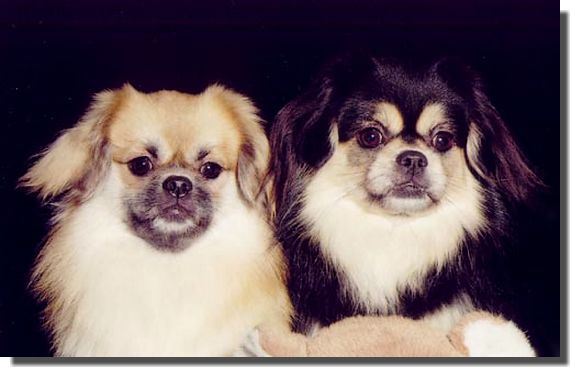
Standard Tibbies - Picture ICS Studio - France

EINLEITUNG
An der Welthundeausstellung 1998 in Helsinki/ Finnland, während der Vereinigung
des ITSWP (International Tibetan Spaniel Working Party), wo ich anwesend war, hatte Herr Primoz Peer, Slowenien Hunde aus
Bhutan vorgestellt.
Viele Züchter interessierten sich an diesen « Eingeborenen ». Ohne
Vorurteil haben wir es erlaubt, unsere Tibet Spaniel Rüden die mit den dort vorgestellten Hündinnen zu decken. Aber mit dem
neuen Apport der produzierten Generationen, gemischt mit Tibet Spaniel, begannen viele Züchter rund um die Welt die Forschung
zu vertiefen, weil die Nachkommen in vielen Punkten wie Morphologie, Winkelungen, Proportionen, Farben, Kopfausdruck, etc.,
ganz und gar nicht dem Tibet Spaniel und Standard entsprachen.
Hier unten etwas « Geschichte » dieser in den letzten Jahren neu
zugeführten Blutlinien im Tibet Spaniel.
Andere weiter in den letzten Jahren importierte Hunde, wie Chotu sind unbekannter
Herkunft.
Chotu
Aus Bhutan nach Deutschland importiert
ohne Ahnentafel - unbekannte Herkunft
(war ursprünglich als Begleithund bestimmt)
Ende 1990 begannen einige Tibet Spaniel Züchter aus verschiedenen europäischen
Ländern mit dem Zuchtprogramm, Damchis aus Bhutan mit Tibet Spaniel zu züchten.
Ist der Damchi in der Kynologie ein Cousin vom Tibet Spaniel, bleibt er doch
eine unterschiedliche Rasse.
Man muss wissen, dass der Tibet Spaniel in der Gruppe 9 (Begleithunde) ist,
die Rasse von England beschützt, und von der Internationalen Kynologischen Gesellschaft (FCI) anerkannt.
Hingegen der Damchi aus Bhutan ist eine bekannte Rasse, aber
NICHT ANERKANNT.
Im Brief der Indischen Federalen Kynologischen Gesellschaft vom 21. Februar
1987 heisst es :
« der Damchi ist eine Rasse von Thimpu
– Bhutan, der königliche Palast in Bhutan hat einige Damchi Terriers, welche den Lhassa Apsos gleichen, mit weniger
Haar das auf Augen fällt und nach verschiedenen Mischungen weniger langes Haar hatte als Terrier, sie nannten ihn « DAMCHI »
und diese Damchis wurden mit Tibet Spaniel verbunden.
Die Basis der verschiedenen Tibet Spaniel Linien ist heutzutage breit und sicher
genügend gross, ohne dass es nötig ist,
Damchis hinein zu züchten um das Überleben der Spaniel zu garantieren.
Bemerkenswerter interessanter Punkt :
Die Besitzerin von Chotu aus Deutschland hat an Juliette Cunliffe (Autorin
der
Enziklopädie der anerkannten oder bekannten Rassen) die Information gegeben,
das Chotu ein « Damchi ist »…
Er ist und unter « andere bekannte Rassen » klassiert, aber vom Englischen
Kennel Klub, Verwahrer des Standards, nicht anerkannt.
Er ist wie folgt beschrieben :
Diese charmante Rasse ist in GEWISSEN
Punkten dem Tibet Spaniel ähnlich und lebt in Bhutan, wo die Leute mit Begleithunden fest verbunden sind.
Das Bild eines Damchi, genannt« Khomy »,
was « mein kleines Baby » bedeutet und welcher dem König von Bhutan gehörte, wurde auf Landesbriefmarken gedruckt.
Trotz einer gewissen Aehnlichkeit mit dem Spaniel, ist der Damchi etwas grösser
(33–43cm) und hat nicht die gleichen Winkelungen und Körperproportionen,
auch die Nase ist etwas länger mit weniger
Fülle.
Einige ursprüngliche Damchis leben in Deutschland, aber ohne neue Importe von
Damchis werden die Damchis in Europa verschwinden.
Die Frage die sich viele Züchter stellen :
Hat es Mischungen mit Damchis und Tibet Spaniel gegeben, welche Tibet Spaniel genannt
wurden?
2001
Leopoldo
von Kyrgyzstan nach Italien
Laura Bonzell aus Rom hatte im 1992 ein Welpe Names Leopoldo auf einem Markt
ind der Stadt FranzBiskek – Kyrgyzstan gekauft. Die Leute die ihn verkauft haben sagten sie haben auch die Eltern und
Schwester, alle sehr ähnlich.
(nicht nur in Farbe / schwarz)
FranzBiskek ist eine Stadt an der alten Seidenstrasse und ist noch ein Ausgangspunkt
der Reisen ins nördliche Tibet.
Leopoldo, wie ein Damchi aussehend, wurde ohne Ahnentafel importiert und
ist jetzt in Slowenien unter FCI Reglement als Tibet Spaniel registriert. Er hat schon einige Würfe produziert und die Welpen
sind in verschiedenen europäischen Ländern.
1999
Arty
Arty, Mutter, Vater und Herkunft unbekannt, nicht eingeschrieben, (keine Ahnentafel).
Ist 1999 geboren, von Nord-West China gekommen. Seine Besitzerin Anita Hummel, wohnhaft im Guand Dong, Provinz in China, bekam
ihn von einem Freund, welcher ihn von einem Landesbeamten erhalten hatte.
Arty ist jetzt…….nachdem ihn drei verschiedene Richter vom Hong-Kong
Kennel Klub begutachtet haben, zertifiert B, was der gleiche Titel ist wie in der FCI, da der HK KK Mitglied der FCI ist.
2005
Erste Nachzucht von Arty
Tchapo Shiwa – Shiwa Ming Mei – Shiwa Yue
(von China nach Schweiz, Schweden, mit
Mitbesitz in Slowenien)
Diese drei Hunde sind am 21.Oktober 2005 geboren, von Rombom Angra (Tibby/Damchi
Linien)
Damchis sind nicht mit den reinen ursprünglichen Linien zu verwechseln.
1994
Eaden of Ada
Von Indien nach Frankreich
Anne-Marie Minotte, Houang-Ho Zucht, importierte am 22 April 1993 eine Hündin, Eaden of Ada,
genannt « Liza » von Herr Sing, Tibet Spaniel Züchter in Indien, -
Downloads -
Schlussfolgerung
(was nur mich selber betrifft)
Ich finde es bedauernd eine Mischung von zwei Rassen zu machen wo doch jede
Rasse sein Charme und seine positiven Punkte hat. Wir werden uns mit Hunden finden, die weder ein Tibet Spaniel noch ein Damchi
sind.
Bestimmt ist der Weltbestand vom Tibby sehr gross und es ist sicher keine Notwendigkeit,
neue Blutlinien hinein zu züchten um zu überleben.
Unbekannten Einheimische zum Tibby einführen, heisst auch, neue unbekannte
Blutlinien mit ihren Krankheiten und schwachen Punkten, welche den nicht definierten Rassen gehören, hinein zu bringen.
Es ist auch eine Nichtanerkennung der langjährigen Arbeit aller Züchter der
Welt.
Ein Züchter, und ich sage richtig « Züchter » und nicht ein Hundehändler
oder Neuling, ein Züchter hat die Leidenschaft, die Kenntnis seiner Rasse, er wird diese Rasse, ihre Geschichte, ihr Ursprung,
ihr Standard, ihre Entwicklung und Charakteristik respektieren, und mit denen zur Verfügung stehenden tierärztlichen Möglichkeiten
auf die Gesundheit achten…
Ein Kennelklub, ein Rassenklub, ein Züchter, alle sollten das gleiche Zielk
verfolgen : ein Tibet Spaniel mit ausgeglichenem Charakter, gesund und dem
FCI Standard konform.
Eine Rasse gehört uns nicht… wir sind die HÜTER…
wir haben kein Recht, diese zu verderben….
Nicht nur der Tibet Spaniel, ist die betroffene Rasse, das kommt auch beim
Tibet Terrier und dem Lhassa Apso vor
Haben wir noch die Möglichkeit, die Echtheit unserer Rassen zu schützen ????


Introduction
At the world dog show in 1998, in Helsinki/Finland, during the meeting of the ITSWP/International
Tibetan Spaniel Working Party, to which I assisted, Mr. Primoz Peer of Slovenia presented dogs from Bhutan.
Many breeders were interested in these dogs known as “Native”, ourselves
even agreed to make cover a few of our tibetan spaniels mâles on the females then presented. But with what was
produced in the first generations with these new contributions, many breeders throughout the world started to look
further into their research because the descendance did not correspond in many points at all to the tibetan spaniel nor
to its standard. by its Morphology, angulations, proportions, colors, expression of head etc
Below a little “history” of these new currents of blood introduced
into the tibetan spaniel during these last years.
Other imports, which as Chotu are dogs with the unknown origins.
Imported New Blood Lines in Europe between 1990-2006
1994
Eaden of Ada – From India to France
Anne-Marie Minotte, Houang-Ho kennel, imported a female called
Eaden of Ada (Liza) from India to France. Liza was born April 22nd 1993. Her breeder is Mr. Y Singh and she is
registered in India under the FCI rules.
.Liza has produced three litters by different stud dogs;
Amko de Karagueuze,
CH Tibroke Ambrier Easy On The Eyes.
CH Chupa Chups of Lollipop
Nice Mic Mac of Lollipop
CH Doux Tam Tam of Lollipop
Teddy
of Lollipop
1998
Chotu – From Bhutan to Germany
Bred in India by Uma Gazner and owned by Martina Krueger in Germany,
first Damchi male Chotu was registered in Slovenia, which accepts the FCI rules. Chotu’s Bhutanese parents are both
unregistered. In India, Chotu had mated his unregistered full sister Lauli-La, and their bitch puppy Silvie was also later
registered in Slovenia. Now Chotu has sired some litters with pure Tibetan Spaniel dams.
In the end of the 1990’s some European Tibetan Spaniels breeders
have had a programme to register Bhutanese Damchis into Tibetan Spaniel breed. We have to start regarding the letter from
Federation of Kennel Clubs of India dated 24th February 1987. They say, ”Damchi is a breed from Thimpu, Bhutan.
The royal palace of Bhutan has quite a few Bhutanese Terriers which are Lhasa Apsos without much hairs falling on the eyes.
Out of these type of crossings, some litters do not have much of a coat and that selective pups are register able as Damchi.
Since then in some countries ‘Damchis’ have been mixed with pure bred Tibetan Spaniels. Referring to the latest
investigations, the gene pool of Tibetan Spaniel breed is large enough for pure breeding.”
The most interesting point of view is that the owner of Chotu gave
the information of these dogs to Juliette Cunliffe, the Author of Encyclopaedia of Dog Breeds where she presents the Tibetan
Spaniel breed like other recognised breeds by the English Kennel Club and Bhutan Damchi, as its own breed, under the chapter
Other Breeds. This chapter includes breeds or varieties of breeds, which are not recognised by the English Kennel Club. In
the Encyclopaedia of Dog Breeds, Juliette Cunliffe gives the presentation of Bhutan Damchi as follows: “This charming
breed is somewhat similar to the Tibetan Spaniel and lives in Bhutan, where people are particularly fond of pets. A Damchi
named Khomyto, meaning ?my little baby`was owned by the former King of Bhutan, and breed has been featured on postage stamps
of the country. Although resembling the Tibetan Spaniel, the Damchi is slightly larger (height 33-43 cm
– 13-17 in)
and more sturdy, with a slightly longer muzzle and less cushioning on the cheeks. A few of these dogs live in Germany with
a breeder who took them back with her from India, but it seems unlikely that the true breed can now survive in Europe unless
new blood is introduced from Bhutan”.
The question is . . . Has crossbreeding happened?
2001
Leopoldo – From Kyrgyzstan to Italy
Laura Borzelli of Rome, Italy bought the male Leopoldo as a puppy in 1992 on
a street market in the city of Frunze/Bishkek, Kyrgyzstan. The people who sold him also bred him, as they had both parents
and a sister, all very similar (not only in colour). Bishkek is a town on the old Silk Route and is still the starting point
for travels to Tibetan plateau from north. This very much Damchi
looking dog is now also registered in Slovenia under the FCI rules.
Leopoldo has sired few litters in Europe.
2006
Tchapo Shiwa, Shiwa Ming Mei, Shiwa Ming Yue – From China
to Switzerland and Sweden
Gisela Fölmli,
Switzerland, imported a male Tchapo Shiwa from Hong Gong, China, co-owned by Primos Peer, Slovenia. The male was born
24th October 2005 out of Rombon Yangra, sired by Arty. Shiwa is bred by Anita Hummel.
His litter sister is named Shiwa Ming Mei and she is owned by
Sandra Klein, Switzerland. The third imported puppy out of this litter is Shiwa Ming Yue, a male owned by Margaretha
Hägglund in Sweden.
The Story of Arty
Arty is an unregistered male and was born 1999. The sire and the dam of Arty are unknown.
He came from North-West China and his owner is Anita Hummel, Guang Dong Province, China. She got Arty through a friend who got
it from a high government official, who had been given him when the dog was a puppy. Arty has now a "B" certificate, after
being inspected by dog show judges of Hong Kong KC. "B certificate" is the same as Conditional FCI registry and getting
conditional pedigree.
Hong Kong KC is a member of FCI and so Arty's puppies will get 2nd generation conditional pedigrees
from Hong Kong KC that will be acknowledged also in FCI/Europe
Conclusion
(which engages only me personally)
I find
regrettable to make a mixing of two breeds where each one of these breeds has its charms and positive points,
we will find ourselves with a dog which will be neither a Tibetain Spaniel nor a Damchi…
To
specify that the world livestock of Tibby is very broad and there is no need to introduce new currents of blood
for its survival or its sauuvegarde
By introducing unknown origins in Tibbies, it is also introducing unknown
currents of blood with their diseases & weak points with the range of none definite breeds behind.
A breeder, not puppy mills breeders or a neophyte, a breeder has the passion & the knowledge
of his breed, will respect the breed, it's history, the origins, the standard, the characteristics,
it's evolution & will take care of his health with the veterinary tools placed at his disposal…
It should
be the goal of the Kennel Club, of the Breed Club, of each breeder, all should seek the same finality…
to work to maintain the breed and to produce healthy pups & in conformity with FCI standard
A breed
does not belong to a breeder… Breeders are the GUARDIANS…
We do not have the right to denature the
breed…

Version Française faisant foi
Un Grand MERCI aux Amis
des diverses races tibétaines
pour les traductions
|

